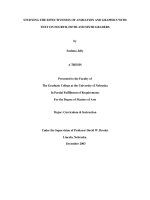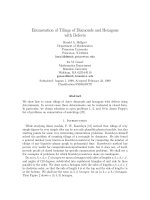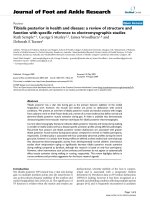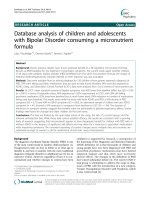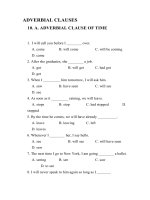dose sparing of opioids and anaesthetics with pre operative dexmedetomidine
Bạn đang xem bản rút gọn của tài liệu. Xem và tải ngay bản đầy đủ của tài liệu tại đây (176.59 KB, 2 trang )
Letters to Editor
Dose sparing of opioids and
anaesthetics with pre‑operative
dexmedetomidine
Sir,
I have read with great interest the recent article
“Attenuation of pressor response and dose sparing
of opioids and anaesthetics with pre‑operative
dexmedetomidine” in this journal of international
repute, and I would like to address some concerns.[1]
This study stresses that dexmedetomidine decreases
the dose of opioid and isoflurane required to achieve
adequate analgesia and anaesthesia.
White in his editorial mentioning the work of Ura states
that 1.3 minimum alveolar concentrations (MAC)
(SD 0.34) isoflurane blocks adrenergic responses to
skin incision and it decreases with concomitant use
of fentanyl.[2] In the study by Lee, the median time
for end‑tidal concentration of isoflurane to reach
80% of inspiratory concentration was 19 min with an
interquartile range of 12 min.[3]
Carbon dioxide (CO2) production and alveolar
ventilation are major determinants of arterial CO2 if
there is no CO2 rebreathing.[4] As alveolar concentration
of CO2 is determined by production of CO2 and fresh
gas flow (FGF), it can be assumed that if CO2 production
is constant then alveolar CO2 is determined by FGF to
alveoli in optimal conditions.[4] In patients with normal
ventilation perfusion ratio, end‑tidal carbon‑di‑oxide
(ETCO2) monitoring can be an estimate of arterial CO2.[5]
As alveolar ventilation is a major determinant governing
uptake of potent inhaled anesthetics,[6] considering the
above‑mentioned facts, every patient should have been
ventilated to a predetermine ETCO2 with predetermined
FGF to remove minute ventilation as the confounding
factor in the study by Bajwa et al. The article mentions
that the concentration of isoflurane was adjusted in
increments of 0.2%, and it was not apparent what the
time limit that was allowed to reach equilibrium.[1] Again
as the mode (manual or mechanical) of ventilation or
the ETCO2 was not specified at any moment during the
study period, I assume that the alveolar concentration
of isoflurane may not have been distributed normally
among the study population.[1]
Considering the above facts, in the study by Bajwa
Indian Journal of Anaesthesia | Vol. 57| Issue 1 | Jan-Feb 2013
et al., a predefined period (to allow equilibration time
prior to skin incision) with a fixed protocol‑based
adjustment of inhalational agent, fresh gas flow, and
ventilation pattern to maintain a predefined end‑tidal
CO2 level was necessary to attain a steady level of depth
of anaesthesia, so that meaningful conclusion could
be drawn regarding fentanyl or isoflurane sparing
effect of dexmedetomidine in the absence of end‑tidal
isoflurane and bispectral index monitoring facility.
Priyam Saikia
Department of Anaesthesiology and Critical Care, Gauhati Medical
College and Hospital, Guwahati, Assam, India
Address for correspondence:
Dr. Priyam Saikia,
Department of Anesthesiology and Critical Care,
Gauhati Medical College and Hospital, Guwahati, Assam, India.
E-mail:
References
1.
2.
3.
4.
5.
6.
Bajwa SJ, Kaur J, Singh A, Parmar S, Singh G, Kulshrestha A,
et al. Attenuation of pressor response and dose sparing of
opioids and anaesthetics with pre‑operative dexmedetomidine.
Indian J Anaesth 2012;56:123‑8.
White D. Uses of MAC. Br J Anaesth 2003;91:167‑9.
Lee DJ, Robinson DL, Soni N. Efficiency of a circle system for
short surgical cases: Comparison of desflurane with isoflurane.
Br J Anaesth 1996;76:780‑2.
Elam JO, Brown ES. Carbon dioxide homeostasis during
anesthesia. III. Ventilation and carbon dioxide elimination.
Anesthesiology1956;17:115‑27.
St John RE. End‑tidal carbon dioxide monitoring. Crit Care
Nurse 2003;23:83‑8.
Eger EI 2nd, Saidman LJ. Illustrations of inhaled anesthetic
uptake, including intertissue diffusion to and from fat. Anesth
Analg 2005;100:1020‑33.
Access this article online
Quick response code
Website:
www.ijaweb.org
DOI:
10.4103/0019-5049.108589
Author’s reply
Sir,
It is always nice to receive the constructive criticism
of one’s research work that can open new avenues for
further improvement in medical sciences. It is also
matter of honor that the concerns have been expressed
by the readers.[1]
93
Copyright of Indian Journal of Anaesthesia is the property of Medknow Publications & Media Pvt. Ltd. and its
content may not be copied or emailed to multiple sites or posted to a listserv without the copyright holder's
express written permission. However, users may print, download, or email articles for individual use.
